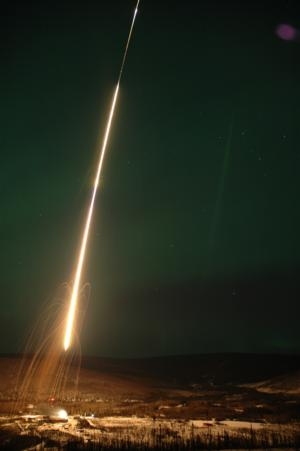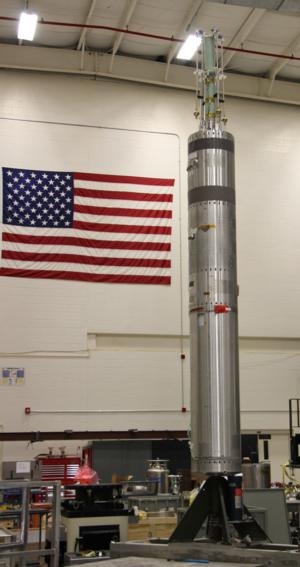Will Explore Effects On Earth’s Atmosphere And Meteorology
The interaction of solar winds and Earth’s atmosphere produces northern lights, or auroras, that dance across the night sky and mesmerize the casual observer. However, to scientists this interaction is more than a light a display. It produces many questions of the role it plays in Earth’s meteorological processes and the impact on the planet’s atmosphere.

To help answer some of these questions, five NASA suborbital sounding rockets carrying university developed experiments will be launched into auroras between 2 and 6 a.m. EST, January 13 through 27, 2015, from the Poker Flat Research Range in Alaska.
The Mesosphere-Lower Thermosphere Turbulence Experiment (MTeX), in conjunction with the Mesospheric Inversion-layer Stratified Turbulence (MIST) explores the Earth’s atmosphere’s response to auroral, radiation belt and solar energetic particles and associated effects on nitric oxide and ozone.
M-TeX consists of two identical payloads flying on NASA Terrier-Improved Malemute sounding rockets approximately 30 minutes apart. Each M-TeX rocket will be followed 2 to 3 minutes later by Terrier-Orion sounding rockets carrying a MIST payload.
Richard Collins, M-TeX principal investigator from the Geophysical Institute at the University of Alaska, Fairbanks, said, “Recent solar storms have resulted in major changes to the composition of the upper atmosphere above 49 miles (80 kilometers), where enhancements in nitrogen compounds have been found. These compounds can be transported into the middle atmosphere where they can contribute to ozone destruction.”
“However, the meteorological conditions do not always allow such transport to occur. Thus, the impact of solar activity on the Earth is not just about how the sun is a source of energetic particles but also how the Earth’s meteorological conditions determine the fate of these particles in the atmosphere,” Collins said.
“Current circulation models show that the transport cannot be explained without the small-scale processes of turbulence and diffusion. These process remain poorly described in the models, and current observations show a wide variation in measurements of turbulence. The turbulence is generated by breaking waves and has characteristics that vary strongly with the background atmospheric conditions,” according to Collins.
He added, “Describing such processes in circulation models is of broad interest, as turbulent and diffusive processes contribute to transport of heat and constituents throughout the atmosphere impacting everything from pollution studies at the surface of the Earth to satellite drag in space.”
The M-TeX payloads, also supported by the Leibniz Institute of Atmospheric Physics at the University of Rostock, Germany, will allow scientists to understand the variability in turbulence.
Collins said, “We will then use these measurements to frame fluid dynamic simulations where we can resolve the characteristics of breaking waves and turbulence and determine the characteristics of turbulence generation, dissipation and diffusion in the middle and upper atmosphere.
Miguel Larsen, MIST principal investigator from Clemson University, South Carolina, said, “MIST will study the characteristics of atmospheric turbulence in the atmosphere/space transition region, and thus, the way atmospheric properties are mixed vertically.”

To help accomplish this, each MIST payload will deploy trimethyl aluminum (TMA) vapor trails between 50 and 87 miles above the Earth. The whitish clouds that are formed will be photographed from several ground stations. Analysis of the data will enable the detection of turbulence.
The TMA vapor tracers do not pose a risk to health or the environment.
The Auroral Spatial Structures Probe (ASSP) will be carried on a NASA Oriole IV (Talos-Terrier-Oriole-Nihka) suborbital sounding rocket to study the heating process in the thermosphere during auroral events and, thus help in developing an understanding of the impact this heating has on satellites orbiting the Earth.
The heating process is known as Joule heating and is well known to all of us.
Charles Swenson, the principal investigator for ASSP with the Space Dynamics Laboratory at Utah State University in Logan, said, “It is simply the process by which an electrical current flowing through a resistive media increases the temperature or heats the media. Examples of this are an electric toaster coil or the heating element in an electric stove, oven or space heater.”
“Electric currents, driven by the solar wind when encountering Earth’s magnetic field, exist in and around the region where aurora occur. These invisible currents heat the thin air of the upper atmosphere of Earth through the Joule heating process,” he said.
Swenson said, “This process is different than the energetic radiation which cause the spectacular visible glow of the dancing northern lights and the scientific community is trying to determine the relative importance of each.”
So how does this heating in the thermosphere impact satellite orbits? Swenson said, “Satellite drag is difficult to predict without a precise understanding of the state of the thermosphere which limits the ability to forecast satellite trajectories. This is especially true when large amounts of electromagnetic energy are dumped into the thermosphere and dissipated through the Joule heating process.”
According to Swenson, “One of the results of heating in and around the aurora is an expanded thermosphere. This expanded gas can increase the drag on satellites (those under or about 620 miles altitude) by 1,000% or more for a few days which shifts their orbits significantly.”
This will be the first flight for ASSP that includes the deployment of six sub-payloads that will be deployed at a high velocity along the flight line and perpendicular to it. The seven payloads (6 sub-payloads plus the main payload) will fly in rapid succession through the same volumes of space making sensitive observations of electric and magnetic fields, Swenson said.
“The energy flow computed will allow scientists to understand when and where the Earth’s thermosphere will heat and expand due to the Joule heating process,” he said.
(Images provided by NASA)
 ANN's Daily Aero-Linx (04.15.24)
ANN's Daily Aero-Linx (04.15.24) Classic Aero-TV: 'No Other Options' -- The Israeli Air Force's Danny Shapira
Classic Aero-TV: 'No Other Options' -- The Israeli Air Force's Danny Shapira Aero-News: Quote of the Day (04.15.24)
Aero-News: Quote of the Day (04.15.24) Airborne 04.16.24: RV Update, Affordable Flying Expo, Diamond Lil
Airborne 04.16.24: RV Update, Affordable Flying Expo, Diamond Lil ANN's Daily Aero-Term (04.16.24): Chart Supplement US
ANN's Daily Aero-Term (04.16.24): Chart Supplement US




